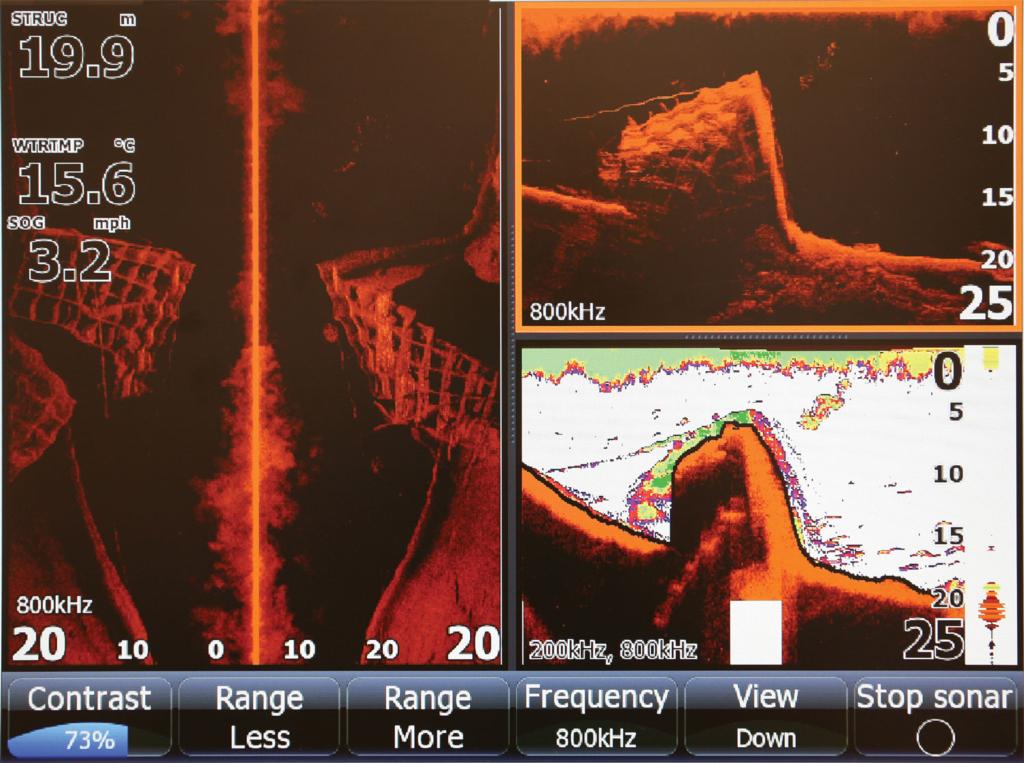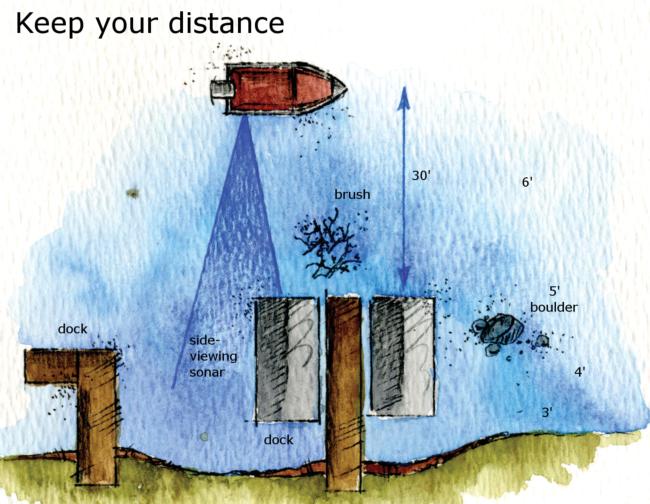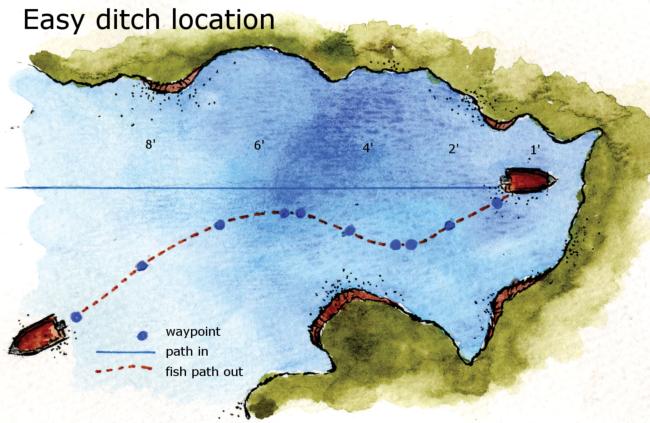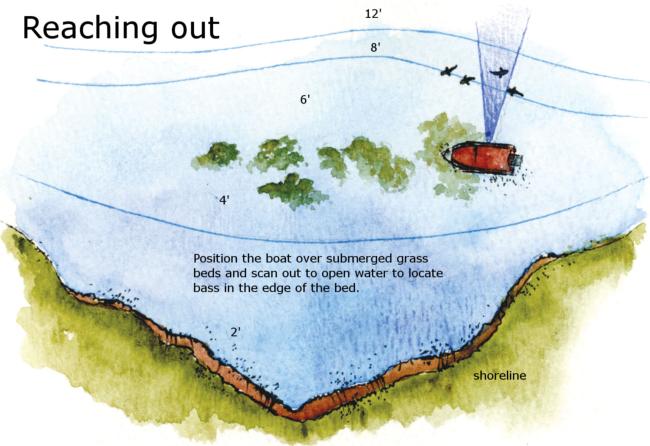The sideways view of shallow water
Lowrance StructureScan isn’t just for deep water. Here’s how it can help you in the shallows

Go to a Walmart FLW Tour event this year and check out the pro’s boats before takeoff. You’ll see proof of the trend that is changing bass fishing.
That trend is the ever-expanding use of side-viewing sonar technology such as Lowrance StructureScan.
Of course, at the top levels of professional bass fishing, adding one of these high-tech fishing tools to a rig is getting to be less of a trend and more of a necessity. The pros that were among the first to use side-scanning sonar benefitted noticeably, to the point that even shallow-water die-hards have joined the stampede toward the new technology. Take, for example, 2010 FLW Tour Angler of the Year Bryan Thrift. The Damiki pro from Shelby, N.C., added a side-viewing unit to his boat for the 2010 season, and it helped him go from being mainly a skinny-water expert to developing into a complete fishing package who can compete offshore as well.
As experimentation continues and knowledge of side-scan technology progresses, some of those shallow-water aces might also discover another benefit of the newfangled units: Even though it’s a powerful tool for deep water, StructureScan and its cousins can also open up shallow patterns that might never have been discovered – and it can help an angler do it faster than any other technology in fishing.
The basics of shallow scanning
If you look at StructureScan with a very basic view, there are three primary advantages of it for shallow-water fishing, as opposed to traditional sonar:
It can actually be used there – Traditional sonar in shallow water was sometimes a worthless tool. Yes, you could spot a sudden drop in depth if you idled over a ditch. And yes, you could get a reading on bottom hardness. But that’s about it. StructureScan, for lack of a better word, “shoots” images off to the side of the boat across shallow flats, under docks and into cover, places you literally could not get above to view with traditional sonar.
The images are much clearer – This applies to StructureScan in any depth, but it bears repeating: The picture-like images of StructureScan are far superior than anything traditional sonar could cough up – ever. You can actually identify objects on the screen, rather than wondering if that blob is a rotting stump or a rusting outboard.
Speed? – Using StructureScan actually requires slow boat movements. When done properly, however, its greatest strength is the ability to speed up the search when faced with miles of shoreline and shallow flats. More about that later.
Find fish, not structure
FLW Tour pro Jim Tutt was one of the first tour pros to get a StructureScan unit when they were released in 2009. At first, as he admits, he didn’t always experiment with it in shallow water as much as he probably should have. That’s understandable, considering its value to him offshore. That changed one day when he was fishing docks on a small lake near his home in Longview, Texas.
“I’ve found on my home lake that some of the boat houses that don’t have any brush under them attract bass just as well as those that do, so I wasn’t using it to look for the brush,” Tutt says. “I was actually using it to look for the fish under the docks. You can see them. That really opened my eyes. There’s a lot more to it than just the structure portion of it. House foundations are always cool to look at, but fish are what we’re after.”
And that is the biggest difference in using StructureScan in the shallows as opposed to offshore, where you don’t always need to see fish with it (although it’s nice when you do). In deeper water you can use it to find good structure where, when the conditions are right, fish will eventually gather. In the shallows, Tutt can see if fish are there when he goes by, so he can try to catch those bass and maybe figure out a pattern. So instead of looking for shallow structure, he looks for shallow fish.
Identifying fish
OK, so what do those individual shallow fish actually look like? According to him, predator fish appear as elongated white “tubes” on the StructureScan (see his actual screen capture above). What the StructureScan can’t always tell an angler is whether the fish is a largemouth bass or a toothy gar. For that, you need to catch one.
However, presuming the fish is a bass, an angler can gauge its size by its proximity to shallow cover. Tutt has made a fine art of it on his home-lake docks with a simple technique.
“What I do is compare the relationship of the size of the dock poles on the screen to the size of the fish on the screen, and that gives me a reference to their true size,” Tutt says. “That was a good tip to pick up because I never really thought about it before. If a structure is 30 or 40 feet deep, you never really know how big the fish on it are until you actually catch one.”
Speed
In order to get the best results with the StructureScan technology, paying attention to boat speed is essential. If you’re pro JT Kenney of Palm Bay, Fla., you just put the boat in gear but don’t give it any more gas. Tutt prefers to idle at a more precise range of about 5 to 6 mph.
Go faster, and the images are distorted; go slower, and the result is likely to be one continuous blurred picture. Traditional sonar can operate effectively at a much faster speed, but StructureScan has it beat in the sense that you can locate and identify quality fishing areas much quicker.
Distance and settings
It’s hard to establish a specific distance that you should keep the boat away from a shallow area when using StructureScan in order to get the best image. It takes some trial and error to determine how close to get to shallow cover to get good readings without spooking fish. Tutt likes to stay about 30 feet away from the boat docks on his home lake. He sets his unit to only show images from the dock side of the boat, and he sets the screen’s scale to show out to 80 feet away from the boat. The 80-foot mark also applies for Tutt in many other shallow cases, but it’s not a hard rule for him.
What’s interesting is that both Tutt and Kenney admit that they typically don’t adjust any other settings on the unit other than the range shown on the screen. They’ve experimented, but neither has found anything better than the “auto” settings from the factory.
That doesn’t mean Kenney and Tutt don’t still experiment. They do, and they suggest others do so as well. If an angler doesn’t experiment with settings and techniques, he’ll never discover the full extent of the benefits StructureScan technology provides.

GPS-SideScan combo
To understand just how much Tutt and Kenney use StructureScan, consider that each has his unit on at all times. Neither would think of doing otherwise. Tutt, perhaps a bit of a minimalist, keeps his single HDS-10 on a split-screen setting, with the StructureScan image on one side and the GPS map on the other.
Kenney, too, always has his GPS map in front of him. But Kenney believes more is better.
“I’ve got two graphs on my console now,” he says. “I’ll never not have two again. I have an HDS-8 in the dash always on a split-screen chart and regular sonar for when I’m running. Then I have an HDS-10 on a RAM Mount that’s always on StructureScan. Even when I’m not looking at stuff I’ll leave it on, and every now and then I’ll get that `holy cow’ moment when I see something amazing.
“As far as I’m concerned, you can’t just have one unit because when you split the screen you lose definition. That’s why I run an HDS-10 for my StructureScan. If you have a smaller screen, you can see that you’re idling by some bridge pilings, but as far as seeing schools of fish or brush, which is one of the hardest things to see on a small screen, the definition is best on a big screen. The other reason for the two screens is, say you’re following a creek channel, you won’t know which way the creek channel is turning if you don’t have your chart up.”
Bottom content
On traditional sonar, bottom hardness is determined by the thickness and color of the return. A hard bottom creates a thin return; a soft bottom is represented as a thick return. Depending on settings, the colors vary. That’s it; whether there’s a hard bottom of pea gravel or some other hard substrate is beyond the unit’s scope. With StructureScan, pea gravel looks like pea gravel, and chunk rock looks like chunk rock.
Even more powerful than identifying bottom content is uncovering bottom-content transitions. Without StructureScan, it’s difficult at best to locate places where the bottom composition changes or one type is surrounded by another.
“It’s amazing to me how many fish just get on a different bottom composition,” Kenney says. “Instead of a brush pile, stake bed or a laydown, they’ll just be on a different type of bottom. You can idle along a flat and the `bottom’ starts getting brighter when you suddenly come to a hard-bottom area. It might only be 100 yards long, but there will be a school of fish on it. Basically, it’s showing you stuff you wouldn’t normally fish.”
The ditch finder
Shallow flats and pockets are the types of areas where StructureScan can be put to best use; what might be a massive area to cover with conventional sonar “shrinks” under its penetrating eyes.
Further, a ditch is one of the top structural elements of a flat or pocket that anglers seek out. With StructureScan, it’s no longer necessary to idle back and forth, watching for the telltale drop and rise of a ditch. When Kenney is looking for a ditch, say in the back of a pocket, he starts idling in about 6 feet of water, going straight down the middle of the pocket toward the back. As soon as he starts “picking up” a ditch on the unit, he moves his cursor over to it and lays down a string of waypoints in the middle of that ditch “channel.” If he sees a turn or corner, he marks that sweet spot with two waypoints.
Then, once he reaches the back of the pocket, he jumps on the trolling motor and fishes his way back out of the pocket, following the string of waypoints. The most important thing to note is that Kenney’s units at the console are connected to the unit at the bow via Ethernet. So when he’s fishing from the front deck, he can see every waypoint he previously marked with the StructureScan.

Checking grass
One area where Tutt has struggled to make hay with his StructureScan is in thick grass. In sparse grass, it’s a killer tool for finding ditches and hard-bottom veins, but he hasn’t figured out yet how to identify fish in thick grass. Kenney might have figured out the answer – for grass deep and shallow.
“Keep your boat in the edge of the grass and shoot out into the open water,” he says. “I’ve learned that I can see fish that are on the edge of the grass that way. I can’t see them in the grass. It only works if they’re on the outside edge of the grass, if you’ve figured out that’s the pattern.”
The bed finder?
A good deal of professional anglers’ shallow-water time is spent fishing for bedding bass. Conveniently, beds can be found using StructureScan. The disclaimer: It’s not easy to find all beds, such as lone beds tucked away within shoreline cover. Plus, if the beds are along the bank in clear water, you’re probably better off searching with your eyes. If the beds are deeper or water clarity is an issue, StructureSan is the ticket.
For instance, say there’s a bed in the middle of a patch of 2- to 3-inch-long grass. Kenney describes this as “fuzzy” grass. The tipoff that a bed is present is a return that shows a bare spot within the grass bed.
Otherwise, Kenney spots beds by looking for dark-colored ovals. The ovals are the beds, and they show up because the base of the bed is lower than the surrounding area and the lip of the bed casts a “shadow” from the sonar.
Of course, bass beds aren’t the only beds anglers look for. Bream beds are much easier to locate because of their size or frequency in an area and the occassional return from bream tending the beds. This is something many pros have taken notice of, and when bass are on a bream-bed pattern, StructureScan is a deadly tool.
